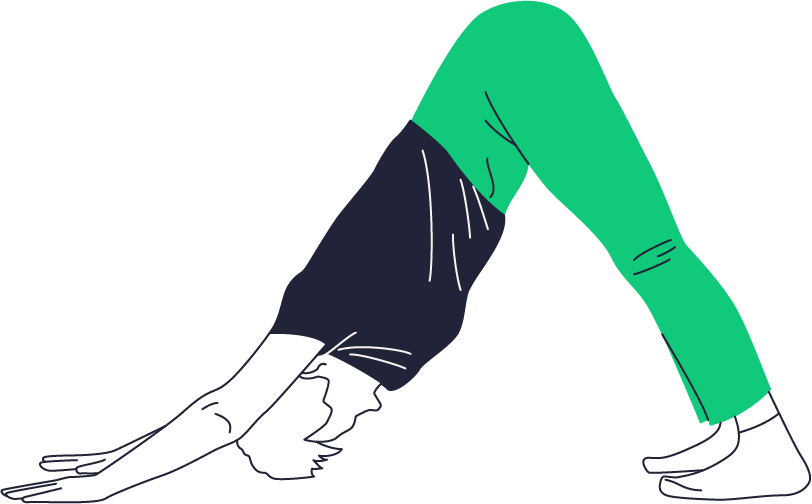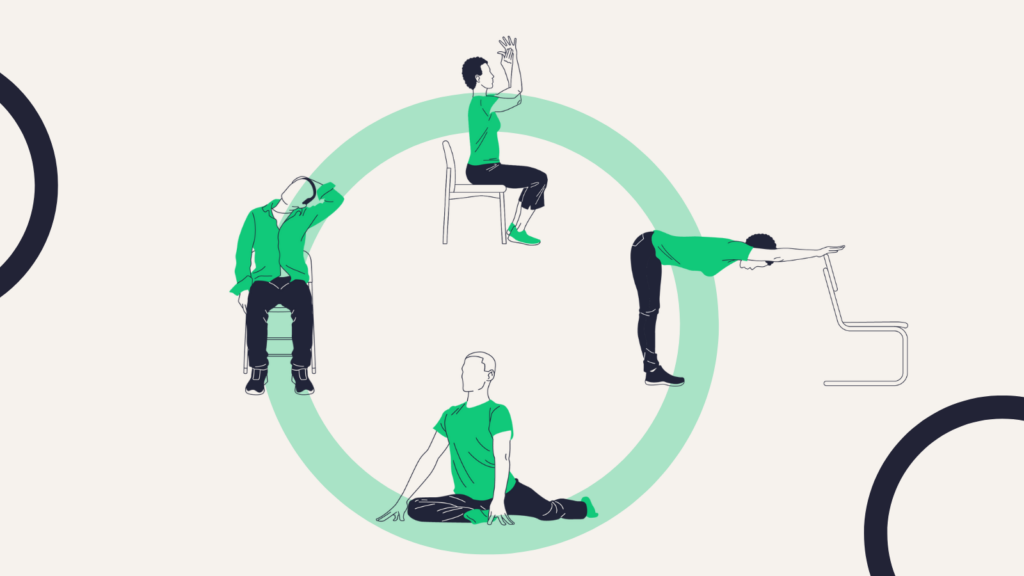Too much time sitting has been linked to a number of health concerns, including weight gain and metabolic syndrome, which is a cluster of conditions including increased blood pressure, and raised blood sugar and cholesterol levels. Regular breaks for movement are often recommended and certainly help, but recent research shows that simple stretches if done regularly can also play a role in supporting the wellbeing of desk based workers by helping to lower blood pressure.
There are many studies in this area, and we have looked at two in particular:
1. The Science – Study 1
A study published in the Journal of Physical Activity and Health in 2021 found that stretching is better than brisk walking at reducing blood pressure for people with blood pressure at the high end of the “normal” range or with low level hypertension.
The study compared 8 weeks of stretching versus walking exercise in 40 men and women with high–normal blood pressure or stage 1 hypertension and concluded that the stretching program resulted in greater reductions than the walking program.
The stretching program consisted of 21 stretching exercises of the neck, shoulders, chest, back, calves, hamstrings, arms, hips and glutes. Each stretch was done twice and held 30 seconds with 15 seconds of rest between stretches.
The walking program consisted of 30-minutes of walking per session, either outdoors or on a treadmill inside. The participants were asked to measure their pulse rate around 10 minutes into the session (or to use a heart rate monitor) and to increase their walking speed if the pulse rate was below their target level.
Both groups participated in supervised sessions 3 days per week and were asked to do the prescribed exercise on their own another 2 days per week.
To help explain the beneficial effect of stretching, the authors of this study point to other recent studies which indicate that stretching of muscles, necessarily involving the stretching of blood vessels, can reduce arterial stiffness, improve blood flow, and increase activation of the parasympathetic nervous system, all of which help to reduce blood pressure.
2. The Science – Study 2
A meta-analysis (that is to say an analysis of the results published by different studies) published in the International Journal of Environmental Research and Public Health in 2020 looked at data from 8 trials relating to middle-aged and older adults who participated in a stretching program compared to control groups who did not.
This analysis suggested that stretching exercises reduced arterial stiffness, heart rate and blood pressure and improved vascular function – the published data showed that the improvements achieved to each metric were significant.
3. Muscles to Stretch
The research indicates that for reduction in blood pressure, the focus should be on large muscle groups that contribute to overall body flexibility and vascular health:
Hamstrings: Back of the thigh
Quadriceps: Front of the thigh
Calves: Lower back of the leg
Hip Flexors: Front of the hip
Glutes: Buttocks
Back Muscles: Lower and upper back
Shoulders and Neck: Upper body and neck muscles
4. Practical Applications
These studies and others suggest that regular stretching can lead to significant improvements in blood pressure and vascular health. To apply these findings in a practical stretching routine:
Make it a habit: Incorporate stretching into the daily routine, such as before work, during breaks, and/or after work.
Frequency: Aim to stretch at least 3-5 times a week, with daily stretching being ideal.
Duration: Hold each stretch for 30 seconds to 1 minute, repeating each stretch 2-4 times.
Targeted Muscle Groups: Focus on the major muscle groups set out above.
Our Stretch for Wellness Sequence is a good place to start Stretch for wellness | YoPO (yoponow.com) and if you only have time for one stretch we love Downward facing dog which targets the whole back surface of the body and the legs as well as opening the shoulders and releasing tension in the neck.

5. Conclusion
Scientific research supports the benefits of stretching for reducing blood pressure and improving vascular health. By incorporating regular stretching into their routine, desk workers can take proactive steps to enhance their cardiovascular health and reduce the risks associated with a sedentary lifestyle.
Helen Withers, Director, YoPO Wellbeing Limited
If you would like any further information on this update or to request access to YoPO’s resource bank of accessible ideas for stretching programmes, please contact hello@yoponow.com.
References
- Stretching is Superior to Brisk Walking for Reducing Blood Pressure in People With High–Normal Blood Pressure or Stage I Hypertension in: Journal of Physical Activity and Health Volume 18 Issue 1 (2020) (humankinetics.com)
- IJERPH | Free Full-Text | The Efficacy of Stretching Exercises on Arterial Stiffness in Middle-Aged and Older Adults: A Meta-Analysis of Randomized and Non-Randomized Controlled Trials (mdpi.com)

